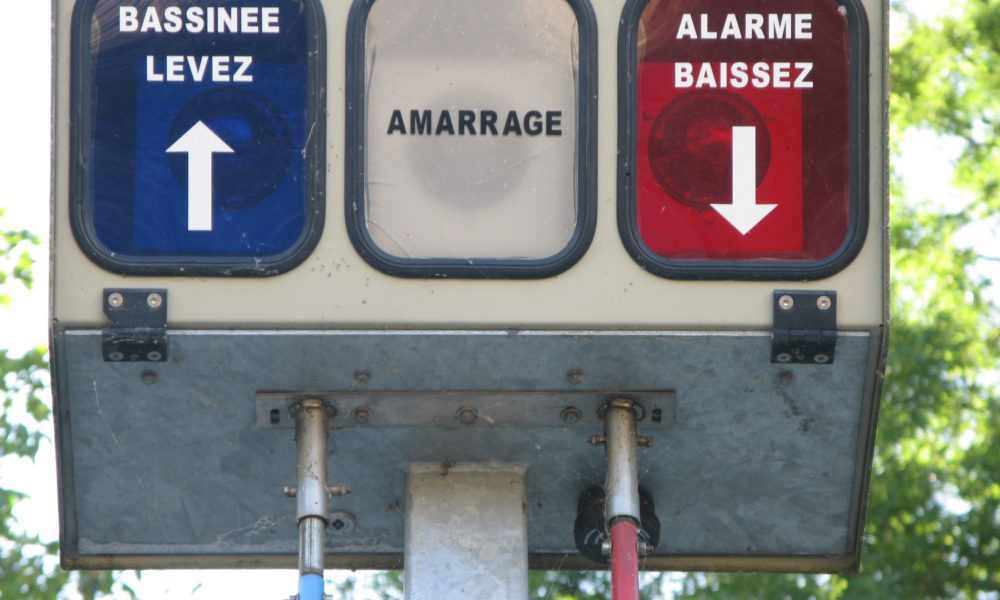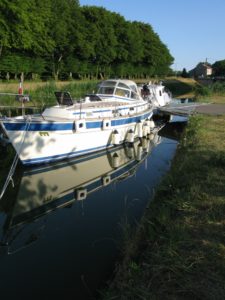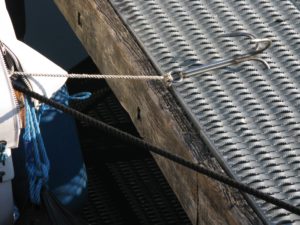Hey! 24 locks in one day…

47° 41′ 2.2524” N 5° 20′ 41.3196” E
July 14, 2015
Effective day. And pretty exhausting. We have agreed with our neighbours from Bruges in Belgium, that we will break up with them as the first of four boats, and that we follow them through the locks. Their boat, Eva, is a broad-obsessed lady, totally strapped into a corset by huge fenders all around. They offer to go first into the locks. We say yes.
The day is laborious. Lock in and lock out. Some locks on this stretch are operated by young students ,who whiz off on their mopeds to make the locks ready for us. Others – the majority – are automated and controlled with the remote control, we have been given. Today’s highlight – literally – is a voyage through a nearly five-kilometre tunnel drilled through the mountain top. Dark, damp, clammy. Water drips onto our heads. The lighting is low, just enough that we can see to keep us in the channel. We keep a flashlight in reserve.
Our start in this tunnel, Balesmes sur-Marne, was governed in good bureaucratic French manner. A series of red and green lights in the tunnel ceiling are holding us back or invite us forward, depending on whether we are sailing too fast or too slowly. Circumstantially and annoyingly engineer-like. One senses that someone sits in a central office and plays with us.
The lock is a turning point. Since the beginning of Canal entre Champagne et Bourgogne, we have only been sailing upwards. 71 locks in total. 340 meters, we have been lifted since the channel start. From now on it is downhill. Right down to the Mediterranean, we think.
We use the first locks after the tunnel to get used to going down. It is said that this is much easier. More gentle to the ship and crew. For us, it is necessary however to catch the technique. In the first locks, we use the same technique, as when we locks up. Two hawsers. One for each, close to each other. It gives a sense of control when it goes up.
But going down there is not as much pressure from floodwaters in the lock chamber. The water disappears quietly under the boat. It is much calmer, and we become comfortable with simply having a single rope to the land, while we are experimenting with making as few moves as possible and let the boat take care of itself. A single puff with a boat hook or a single jerk in the hawser is enough. Yes, obviously it is easier to lock down than up. If it were not for the sun and heat, it would be pure relaxation.
We say goodbye to the Belgians after having sailed with them through 20 locks. Although we are taking additional four locks to Dommarien, which according to the map is a berth with 1.80 meters depth for two boats. It is not.
We hit the ground long before, we reach the quayside.
Instead we sail to the right side of the canal, where a converted peniche populated with young French people is located at the brink. We ask if we can moor side by side with them. No. They ask us to find another place. Rather unheard of. Sailors always give each other space. But they are probably landlubbers. Not sailors. Kirsten, frustrated, calls all sorts of curses upon the young landlubbers.
We must try again on the berth assigned in the chart. Nope. It is impossible. We cannot reach the shore. There continues to be one to one and a half meters between Ronja and the brink. We choose to make the boat stuck on this distance of the brink with the assistance of a helpful Frenchman. Well, anyway it does not seem temptating at all to go ashore, so we do not.
The helpful Frenchman seems to be new to sailing life. He has a small motorboat, which he has connected to the shore with three ropes and an anchor, which he has fixed on top of a little metal-bridge. We have never seen this before.
We celebrate with champagne today, the impressive distance and the fact that we have passed the peak and that the next few weeks of sailing goes down towards Saone, Rhone and the Mediterranean. A clear turning point.
Log book: Today’s distance: 35 km. Sailed time 8:45 to 19:15 = 10 ½ hour. Locks: 24 !!!! Weather: Sun all day. Light breeze made sure to dampen the unit. In these waters, the wind has only one meaning: To cool. To the navigation it has virtually no impact.

Sometimes you have to improvise finding mooring for Ronja

Not alle french sailors are trained in the craft of mooring. Her is a peculiar use of an anchor